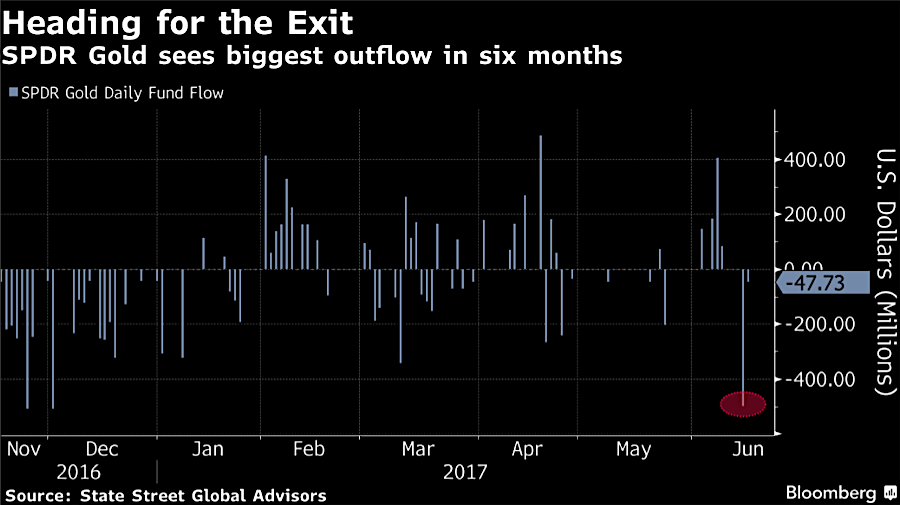By Luzi-Ann Javier
Hedge funds were smart enough to get ahead of Janet Yellen’s bad news for the gold market.
Money managers pared their net-bullish wagers in the metal for the first time in four weeks. The next day, the move was vindicated when Federal Reserve Chair Yellen raised U.S. interest rates and sparked the biggest weekly loss for gold prices in more than a month.
After posting gains earlier this year, the precious metal could be heading for a turning point. The Fed reiterated plans for another hike in 2017, while the European Central Bank is reviewing whether to maintain its loose monetary policy. Higher borrowing costs curb the appeal of bullion, which pays no interest. Investors in SPDR Gold Shares, the largest exchange-traded fund backed by bullion, are pulling money out at the fastest pace this year.

“Gold probably heads lower here, just because of the fundamental factors lining up against it,” said Rob Haworth, a Seattle-based senior investment strategist at U.S. Bank Wealth Management, which oversees $142 billion. “The Fed is on this path for better or for worse, to normalize rates. We’re getting good growth in Europe and the ECB is certainly not in the position where it has to add to accommodation.”
Money managers cut their gold net-long position, or the difference between bets on a price increase and wagers on a decline, by 11 percent to 155,037 futures and options contracts in the week ended June 13, according to U.S. Commodity Futures Trading Commission data released three days later.
Gold futures fell 1.2 percent last week to settle at $1,256.50 an ounce on the Comex in New York, its biggest decline since May 5. There’s little optimism in the market, with traders and analysts surveyed by Bloomberg News bearish on the metal for a second straight week, a trend not seen since December. Futures slipped further to $1,252.20 on Monday.
In addition to raising borrowing costs, Fed officials also kept their projections for three more increases in 2018 and set out some details on shrinking their $4.5 trillion balance sheet. Yellen’s statement on June 14 played down concerns of softening inflation, dousing hopes for gold bulls who were betting recent disappointing economic data would prompt policy makers to walk back the rate trajectory.
As rates climb in the U.S., there are a growing number of officials at the Bank of England favoring raising borrowing costs, while the European Central Bank ruled out further interest-rate cuts.
There are other signs that investors are growing skeptical of a gold rally. Traders dumped options contracts in New York betting on further gains. Prices for a call giving owners the right to buy the metal at $1,400 by December, the option with the highest open interest, tumbled 30 percent last week.
Still, not everyone is pessimistic on gold’s outlook. Analysts Suki Cooper of Standard Chartered Plc and Daniel Hynes of Australia & New Zealand Banking Group Ltd. said gold typically rebounds after rate-hike cycles. The metal is “a store of wealth in unstable times and, while global finance has weathered a decade of storms, the future is uncertain,” Sydney-based Hynes wrote in a report June 14.
Yellen expressed confidence that an ever-tightening job market will eventually lift wages and inflation, but not everything is rosy with the U.S. economy. Even before the Fed meeting ended on June 14, the Commerce Department released figures showing retail sales fell in May by the most since the start of 2016. A day later, separate data showed factory output declining, while homebuilder sentiment slipped.
While there are reasons that make it not as “compelling to own gold,” an uneven U.S. economy has “caused some to question whether the Fed might be too aggressive in raising rates and contracting the balance sheet,” said Walter “Bucky” Hellwig, who helps manage $17 billion as senior vice president at BB&T Wealth Management in Birmingham, Alabama.